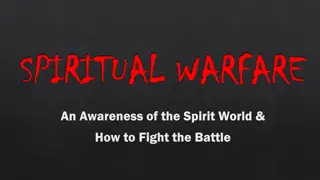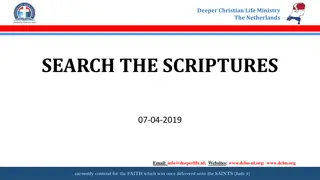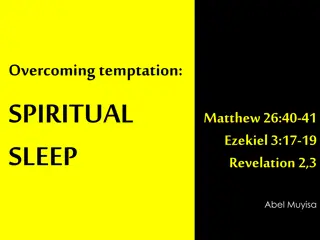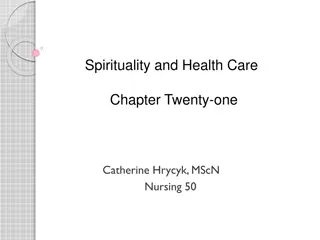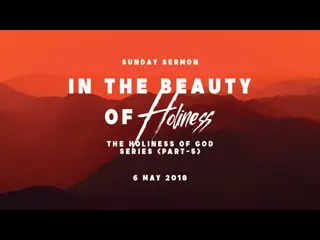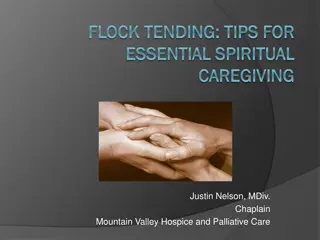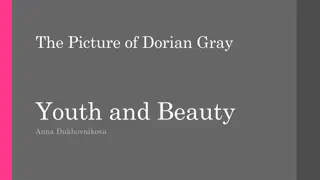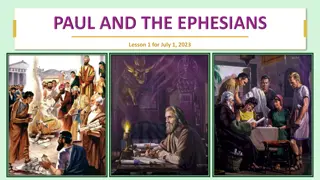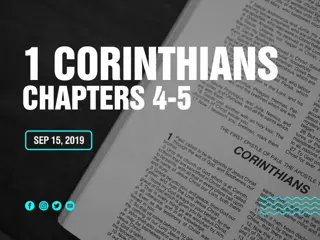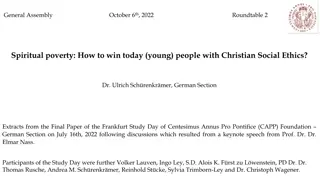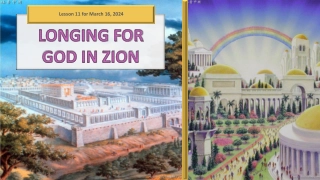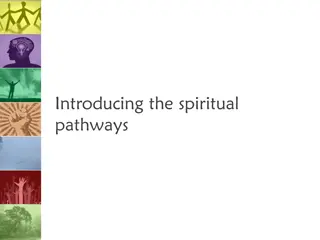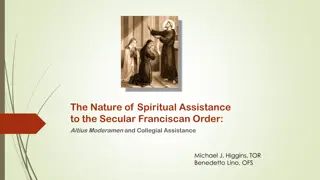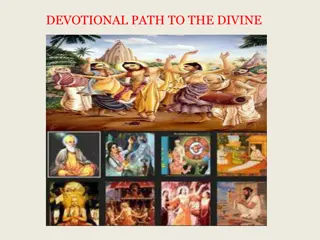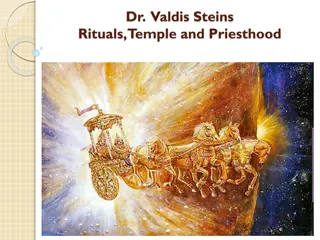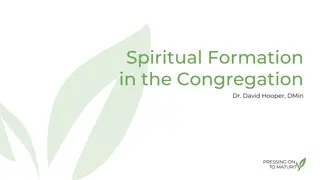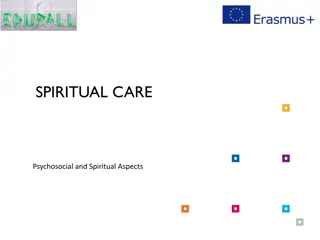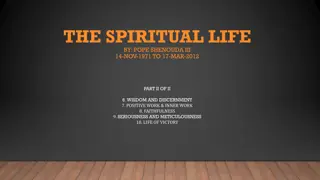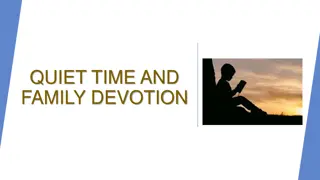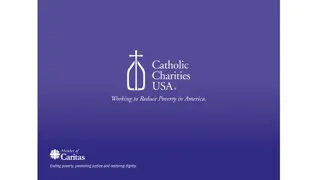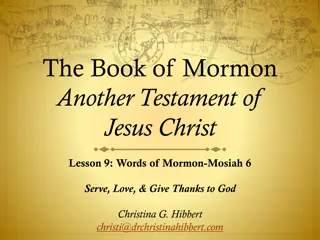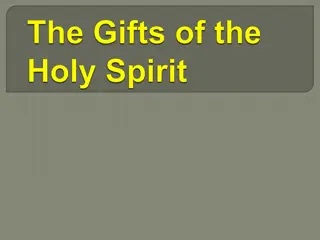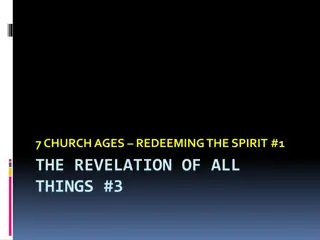The Way of Beauty: Navigating Spiritual Challenges in Modern Times
The phenomena of new religiosity and emerging spiritualities present a key challenge for evangelization, touching on the evolving dynamics within contemporary societies. Amidst this landscape, the Way of Beauty emerges as a profound pathway for individuals grappling with moral teachings and seeking deeper spiritual connection. Through the lens of beauty, the search for God is illuminated, paving the way for encounters with divine truths and the eternal Beauty embodied by Christ. This journey beckons individuals to perceive the inherent goodness in creation and embrace the transformative power of art and beauty in revealing spiritual epiphanies.
Download Presentation

Please find below an Image/Link to download the presentation.
The content on the website is provided AS IS for your information and personal use only. It may not be sold, licensed, or shared on other websites without obtaining consent from the author. Download presentation by click this link. If you encounter any issues during the download, it is possible that the publisher has removed the file from their server.
E N D
Presentation Transcript
THE WAY OF BEAUTY, VIA PULCHRITUDINIS DIOCESE OF PHOENIX
The phenomena of new religiosity and emerging spiritualities spreading across the world are a major challenge for the new evangelisation. They pretend to meet the spiritual, emotive and psychological needs of our contemporaries better than the Church and traditional religious formats. Through syncretistic and esoteric practices they touch the sparks of emotion in people in a communitarian and pseudo-religious dynamic that often stifles them, or deprives them of their liberty and their dignity. Pontifical Council for Culture 2
Christians remain a living force capable of witnessing with discernment and courage at the heart of neo-pagan culture, even though in some traditionally Christian countries practising Christians are no longer the majority of the country. PCC 3
In this perspective, the Way of Beauty seems to be a privileged itinerary to get in touch with many of those who face great difficulties in receiving the Church's teachings, particularly regarding morals. Too often in recent years, the truth has been instrumentalised by ideologies, and the good horizontalised into a merely social act as though charity towards neighbour alone sufficed without being rooted in love of God. Relativism, which finds one of its clearest expressions in the pensiero debole, continues to spread, encouraging a climate of miscomprehension, and making real, serious and reasoned encounters rare.
Beginning with the simple experience of the marvel-arousing meeting with beauty, the via pulchritudinis can open the pathway for the search for God, and disposes the heart and spirit to meet Christ, who is the Beauty of Holiness Incarnate, offered by God to men for their salvation. It invites contemporary Augustines, unquenchable seekers of love, truth and beauty, to see through perceptible beauty to eternal Beauty, and with fervour discover Holy God, the author of all beauty.
LETTER OF HIS HOLINESS POPE JOHN PAUL II TO ARTISTS 1999 To all who are passionately dedicated to the search for new epiphanies of beauty so that through their creative work as artists they may offer these as gifts to the world. God saw all that he had made, and it was very good (Gn 1:31)
LETTER TO ARTISTS 1. None can sense more deeply than you artists, ingenious creators of beauty that you are, something of the pathos with which God at the dawn of creation looked upon the work of his hands. A glimmer of that feeling has shone so often in your eyes when like the artists of every age captivated by the hidden power of sounds and words, colours and shapes, you have admired the work of your inspiration, sensing in it some echo of the mystery of creation with which God, the sole creator of all things, has wished in some way to associate you. 1
What is the difference between creator and craftsman? The one who creates bestows being itself, he brings something out of nothing ex nihilo sui et subiecti, as the Latin puts it and this, in the strict sense, is a mode of operation which belongs to the Almighty alone. The craftsman, by contrast, uses something that already exists, to which he gives form and meaning. This is the mode of operation peculiar to man as made in the image of God. In fact, after saying that God created man and woman in his image (cf.Gn 1:27), the Bible adds that he entrusted to them the task of dominating the earth (cf.Gn 1:28). This was the last day of creation (cf.Gn 1:28-31). On the previous days, marking as it were the rhythm of the birth of the cosmos, Yahweh had created the universe. Finally he created the human being, the noblest fruit of his design, to whom he subjected the visible world as a vast field in which human inventiveness might assert itself. 1
3. A noted Polish poet, Cyprian Norwid, wrote that beauty is to enthuse us for work, and work is to raise us up .
The theme of beauty is decisive for a discourse on art. It was already present when I stressed God's delighted gaze upon creation. In perceiving that all he had created was good, God saw that it was beautiful as well.(4) The link between good and beautiful stirs fruitful reflection. In a certain sense, beauty is the visible form of the good, just as the good is the metaphysical condition of beauty. This was well understood by the Greeks who, by fusing the two concepts, coined a term which embraces both: kalokagath a, or beauty-goodness. On this point Plato writes: The power of the Good has taken refuge in the nature of the Beautiful .
16. On the threshold of the Third Millennium, my hope for all of you who are artists is that you will have an especially intense experience of creative inspiration. May the beauty which you pass on to generations still to come be such that it will stir them to wonder! Faced with the sacredness of life and of the human person, and before the marvels of the universe, wonder is the only appropriate attitude. From this wonder there can come that enthusiasm of which Norwid spoke in the poem to which I referred earlier. People of today and tomorrow need this enthusiasm if they are to meet and master the crucial challenges which stand before us. Thanks to this enthusiasm, humanity, every time it loses its way, will be able to lift itself up and set out again on the right path. In this sense it has been said with profound insight that beauty will save the world .(25) Beauty is a key to the mystery and a call to transcendence. It is an invitation to savour life and to dream of the future. That is why the beauty of created things can never fully satisfy. It stirs that hidden nostalgia for God which a lover of beauty like Saint Augustine could express in incomparable terms: Late have I loved you, beauty so old and so new: late have I loved you! .(26)
EVANGELIIUM GAUDIUM POPE FRANCIS 167. Every form of catechesis would do well to attend to the way of beauty (via pulchritudinis).[129] Proclaiming Christ means showing that to believe in and to follow him is not only something right and true, but also something beautiful, capable of filling life with new splendour and profound joy, even in the midst of difficulties. Every expression of true beauty can thus be acknowledged as a path leading to an encounter with the Lord Jesus.
This has nothing to do with fostering an aesthetic relativism[130] which would downplay the inseparable bond between truth, goodness and beauty, but rather a renewed esteem for beauty as a means of touching the human heart and enabling the truth and goodness of the Risen Christ to radiate within it. If, as Saint Augustine says, we love only that which is beautiful,[131] the incarnate Son, as the revelation of infinite beauty, is supremely lovable and draws us to himself with bonds of love. So a formation in the via pulchritudinis ought to be part of our effort to pass on the faith. Each particular Church should encourage the use of the arts in evangelization, building on the treasures of the past but also drawing upon the wide variety of contemporary expressions so as to transmit the faith in a new language of parables .[132]We must be bold enough to discover new signs and new symbols, new flesh to embody and communicate the word, and different forms of beauty which are valued in different cultural settings, including those unconventional modes of beauty which may mean little to the evangelizers, yet prove particularly attractive for others.
Each particular Church should encourage the use of the arts in evangelization, building on the treasures of the past but also drawing upon the wide variety of contemporary expressions so as to transmit the faith in a new language of parables .[132]We must be bold enough to discover new signs and new symbols, new flesh to embody and communicate the word, and different forms of beauty which are valued in different cultural settings, including those unconventional modes of beauty which may mean little to the evangelizers, yet prove particularly attractive for others.
POPE BENEDICT XVI SCREENING OF THE DOCUMENTARY FILM "ART AND FAITH - VIA PULCHRITUDINIS" ADDRESS OF HIS HOLINESS POPE BENEDICT XVI Paul VI Audience Hall Thursday, 25 October 2012 One could say that the artistic patrimony of Vatican City constitutes a kind of great parable through which the Pope speaks to men and women of every part of the world, and so from many cultures and religions, people who might never read one of his Discourses or Homilies. This brings to mind what Jesus said to his disciples: to you the secret of the Kingdom of God has been given, but to those on the outside everything is said in parables (Mk 4:10-12). The language of art is a language of parables, endowed with a special universal openness: the via Pulchritudinis is a path to guide the mind and the heart to the Eternal, to elevate them to the heights of God.
I much appreciated the fact the film repeatedly refers to the Roman Pontiffs commitment to the preservation and promotion of the artistic patrimony; and also, in today s age, to the renewed dialogue of the Church with artists. The Vatican Museums Collection of Modern Religious Art is a practical example of this fruitful dialogue. But this is not all. The entire great body of the Vatican Museums which is actually a living reality also possesses what could be called an evangelizing dimension! And we see, that these works on display depend upon work that is not seen, that is totally indispensable for their best preservation and display.
Art and faith: a combination that has accompanied the Church and the Holy See for 2,000 years, a combination that still today we must value more in our commitment to the men and women of our time to proclaim the Gospel, to proclaim the God who is Beauty and infinite Love.
THE BEAUTY OF HOLINESS AND THE HOLINESS OF BEAUTY First, taking my inspiration from Hans Urs von Balthasar, I want to expound a theological aesthetic of Christian sanctity of art I am not trying to reduce the Creed to subjective impressions of beauty, to pretty poetry and suggestive symbols, but to perceive- through holy men and holy images-the objective glory of divinely revealed truth. John Saward, 22
To enliven dogmatic and pastoral theology with an infusion of hagiography and iconography the sanctity of the theologians gave the People of God a great a great confidence in their teaching. Saward, 24
When Christian men are martyred, so is Christian art. Iconoclasm did not die with the triumph of orthodoxy in 843. In post- Reformation England, the burning and the breaking of holy beauty was the work not only of Cromwell s soldiery in the seventeenth century but of Anglicanism s founding fathers in the sixteenth the iconoclasm of the English Reformers was more violent even then that of Calvin and Zwingli, who at least opposed the breaking of stained glass; but the in Injunctions of Edward VI in 1547, even imagery in windows was to be destroyed (Saward , 183).
The war on holy beauty in the England of Edward and Elizabeth was total war. To quote Mrs. Aston What started with monastic shrines and abused pilgrimage images, progressed to pictures and statues of all kinds, to church windows, to the crucifix, even to the cross itself. From the removal of some images the issue became the annihilation of them all. Images generated passionate feelings, and iconoclastic arguments were always several steps ahead of official enactments . (Aston, England s Iconoclasts, Saward 185).
THE CATECHISM OF THE CATHOLIC CHURCH 2500 Catechism of the Catholic Church 2500 The practice of goodness is accompanied by spontaneous spiritual joy and moral beauty. Likewise, truth carries with it the joy and splendor of spiritual beauty. Truth is beautiful in Itself. Truth in words, the rational expression of the knowledge of created and uncreated reality, is necessary to man, who is endowed with intellect. But truth can also find the complementary forms of human expression, above all when it is a matter of evoking what is beyond words: the depths of the human heart, the exaltations of the soul, the mystery of God
Even before revealing himself to man in words of truth, God reveals himself to him through the universal language of creation, the work of his Word, of his wisdom: the order and harmony of the cosmos Which both the child and the scientist discover - "from the greatness and beauty of created things comes a corresponding perception of their Creator," " for the author of beauty created them.
REVELATION If God is beauty, the revelation of God is a revelation of beauty and must itself be beautiful. Beauty, the capacity to produce joy through perception, characterizes God s historical revelation to the extent that the latter is faithfully received. But it is beauty that demands conversion. Richard Viladesau, Theology and the Arts
Sacred art is true and beautiful when its form corresponds to its particular vocation: evoking and glorifying, in faith and adoration, the transcendent mystery of God - the surpassing invisible beauty of truth and love visible in Christ, who "reflects the glory of God and bears the very stamp of his nature," in whom "the whole fullness of deity dwells bodily. This spiritual beauty of God is reflected in the most holy Virgin Mother of God, the angels, and saints. Genuine sacred art draws man to adoration, to prayer, and to the love of God, Creator and Savior, the Holy One and Sanctifier. CCC 2502
For this reason bishops, personally or through delegates, should see to the promotion of sacred art, old and new, in all its forms and, with the same religious care, remove from the liturgy and from places of worship everything which is not in conformity with the truth of faith and the authentic beauty of sacred art. CCC 2503
DEEP THIRST FOR ENDLESS BEAUTY You and I, each and every one of us without exception, can be defined as an aching need for the infinite In other words, their inner spirit is clamoring, even if confusedly, for unending beauty. How they and we respond to this inner outreach rooted in our deep spiritual soul is the most basic set of decisions we can make: they have eternal consequences. Thomas Dubay, Evidential Power of Beauty, 17
ST. JOHN MARY VIANNEY To attract people to his church, he made up his mind to approve its appearance- which would not only attract people, but would also make it less unworthy for God He could never find any ornaments splendid enough to clothe the priest when he represented God, the High Priest. Of all the money that he was to receive in the future-and he received a great deal-what did not go to the poor was poured out with splendid generosity for the beautifying of these services to the honour of God. Henri Gheon, 35
Perhaps like certain other saints, he possessed a mysterious sense which made him prefer the more beautiful as being more true. Gheon, 36
HALLMARKS OF BEAUTY, THOMAS AQUINAS Radiance-Claritas Due proportion-Bonum Wholeness-Intengritas




